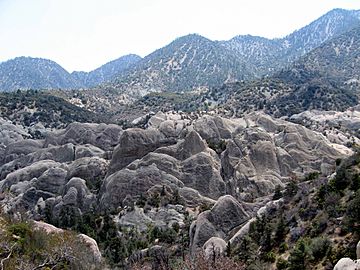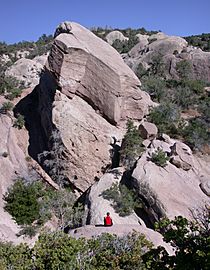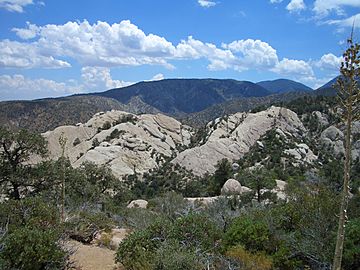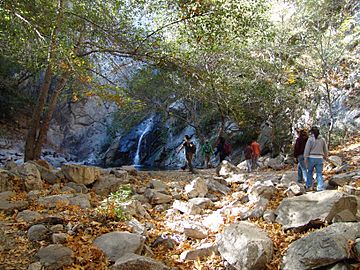Punchbowl Formation facts for kids
Quick facts for kids Punchbowl FormationStratigraphic range: Mid-Late Miocene (Clarendonian-Hemphillian) ~14–8Ma |
|
|---|---|

Outcrop of the tilted formation at the eponymous Devil's Punchbowl
|
|
| Type | Formation |
| Underlies | Crowder Formation |
| Overlies | Paradise Springs Formation |
| Lithology | |
| Primary | Conglomerate, sandstone |
| Other | Mudstone |
| Location | |
| Coordinates | 34°00′N 118°12′W / 34.0°N 118.2°W |
| Approximate paleocoordinates | 33°24′N 114°24′W / 33.4°N 114.4°W |
| Region | Los Angeles County, California |
| Country | |
| Extent | San Gabriel Mountains |
| Type section | |
| Named for | Devil's Punchbowl |
| Named by | Noble |
| Year defined | 1953 |
The Punchbowl Formation is a special type of rock layer found in the northern San Gabriel Mountains in southern California. It's mostly made of sandstone and other rocks that have settled over millions of years. This formation is famous because you can see it clearly at a place called the Devil's Punchbowl, which is a cool park in Los Angeles County.
Contents
What is the Punchbowl Formation?
The Punchbowl Formation is a geologic formation. This means it is a body of rock layers that geologists have identified and named. It is made of sedimentary rock, which forms from bits of sand, mud, and pebbles that get pressed together over a very long time.
You can see these rock layers in the walls of the Devil's Punchbowl. This is a beautiful gorge inside the Devil's Punchbowl Natural Area. This area is a park within the Angeles National Forest.
How did the Punchbowl Formation form?
The rocks of the Punchbowl Formation were formed between 14 and 8 million years ago. This was during a time called the Middle to Late Miocene epochs.
Over millions of years, three different faults (cracks in the Earth's crust) have pushed and folded these rock layers. The Devil's Punchbowl itself is a large "plunging sandstone syncline". Imagine a giant U-shape in the rock. The edges of this U-shape have been pushed upwards, while the center has dipped down.
This amazing shape was created by the Punchbowl Fault. This fault is very close to the famous San Andreas Fault to the north.
The Punchbowl Formation is about 1,500 meters (almost a mile) thick! It is made up of different kinds of rocks:
- Conglomerates: These are rocks made of rounded pebbles and larger stones cemented together. They were likely carried by rivers (fluvial) or deposited by floods (alluvial).
- Sandstones: These are rocks made from sand grains.
- Mudstones: These are rocks made from very fine mud and clay particles.
These rocks were laid down by ancient rivers and streams. They formed during the middle to late Miocene epoch.
The water from the Devil's Punchbowl flows into Sandrock Creek. This creek then joins Big Rock Creek, which eventually disappears into the Mojave Desert.
What fossils are found in the Punchbowl Formation?
The rocks in the Punchbowl Formation hold amazing clues about ancient life. They contain fossils of animals that lived here about 5 to 10 million years ago. This time period is known as the Neogene Period of the Cenozoic Era.
Mammals
Many different types of ancient mammals have been found here.
Artiodactyls
These are hoofed mammals that usually have an even number of toes.
- Aepycamelus alexandrae (an ancient camel)
- Bouromeryx americanus
- Brachycrus cf. buwaldi
- Dyseohyus fricki
- Pseudoparablastomeryx cf. scotti
- Brachycrus sp.
- Plioceros sp.
- Antilocapridae indet. (related to modern pronghorns)
- Blastomerycinae indet.
- Camelidae indet. (ancient camels)
- ?Merycoidodontidae indet.
- Tayassuidae indet. (ancient peccaries, like small wild pigs)
Perissodactyls
These are hoofed mammals that usually have an odd number of toes.
- Archaeohippus mourningi (an early horse)
- Parapliohippus cf. carrizoensis
- Pliohippus cf. tehonensis
- Scaphohippus intermontanus
- S. sumani
- Cormohipparion sp.
- ?Archaeohippus sp.
- Equini indet. (ancient horses)
- Hipparionini indet.
- Rhinocerotidae indet. (ancient rhinoceroses)
Carnivora
These are meat-eating mammals.
- Borophagus cf. secundus (an ancient dog)
- Leptarctus ancipidens
- Plionictis sp.
Rodents
These are gnawing mammals.
- Petauristodon sp.
- Sciuridae indet. (ancient squirrels)
Reptiles
Turtles
- Gopherus depressus (an ancient tortoise)
Gallery
-
Formation in the Angeles National Forest
-
Formation at Sturtevant Falls





